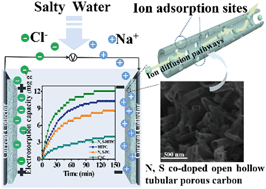High-performance water desalination of heteroatom nitrogen- and sulfur-codoped open hollow tubular porous carbon electrodes via capacitive deionization†
Abstract
Capacitive deionization (CDI) is a competent technique for water desalination on account of its low energy consumption, easy operation and environmental friendliness. In this work, heteroatom nitrogen- and sulfur-codoped open hollow tubular porous carbon (N,S-HTPC) with a hierarchical porous tube wall and high specific surface area (1412 m2 g−1) has been successfully fabricated via a facile MnO2-nanorod template method, in which LB agar coupled with β-cyclodextrin hydrogel (LB agar@β-CD hydrogel) was employed as carbon, nitrogen and sulfur sources. The obtained N,S-HTPC possessed a unique open hollow tubular structure with micropores–mesopores distributed in the tube wall and excellent N, S doping properties. The open hollow tubular structure of N,S-HTPC electrodes could guarantee unimpeded ion diffusion inside the carbon tubes, and the micro-/mesopores in the tube wall provided sufficient diffusion pathways and more adsorption sites for ion transport and capture. In addition, the incorporation of N and S in the carbon matrix resulted in excellent charge and ion transportation ability and excellent conductivity and hydrophilicity. Compared with open hollow tubular porous carbon (HTPC) and N, S co-doped porous carbon (N,S-PC), N,S-HTPC displayed a remarkable capacitive deionization behavior with a high electrosorption capacity (12.05 mg g−1) at 1.2 V in a 25 mg L−1 NaCl solution. The heteroatom co-doped hierarchical porous carbon with unique channels, low energy consumption and stable regeneration performance has provided great potential for the development of high-performance CDI.



 Please wait while we load your content...
Please wait while we load your content...